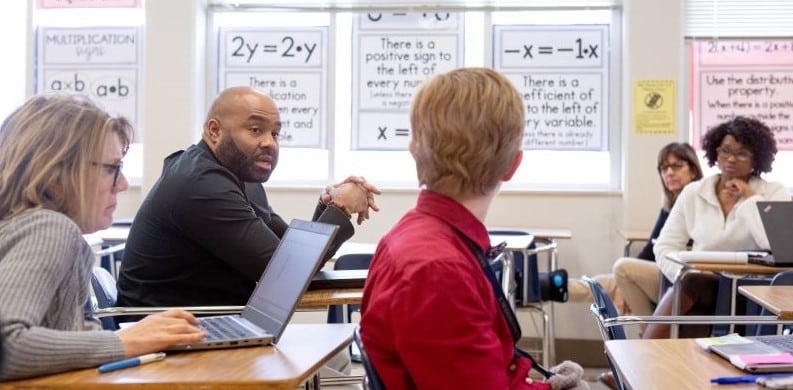Key Points
- The practical constraints on teachers’ time present a significant obstacle to the wider adoption of team teaching.
- To make team teaching viable, we need innovations that can dissolve these practical constraints and facilitate efficient and sustainable collaboration within existing cost structures.
Teacher burnout is a real and growing challenge for US K–12 schools. Last year, school district leaders reported a 4% increase in teacher turnover according to a nationally representative survey from RAND. In some states like Louisiana and North Carolina, Chalkbeat found that total departures surged to more than 13%. This unsettling trend, coupled with the increasing pressures on those who remain, is a problem we can’t afford to ignore.
For a number of years, I’ve been encouraged by one potential solution to this challenge: team teaching—in particular, the Opportunity Culture work by Public Impact found in hundreds of schools, or ASU’s Next Education Workforce initiative. I struggled as a first-year teacher, and I would have relished the opportunity to work side-by-side with more experienced teachers so I could observe their methods and have a second adult present to navigate difficult classroom situations.
Yet, despite the potential benefits of team teaching, it’s a practice that has struggled to gain widespread adoption, even though it’s been around for decades. Education historian Larry Cuban, in a blog post from a few years back, traced the ebb and flow of enthusiasm for team teaching from the 1950s to the 1970s. As Cuban suggests, team teaching has long been seen as the antidote to the inflexible, individualistic teaching within age-graded, self-contained classrooms.
So, why hasn’t such a promising practice truly taken flight?
Time hinders team teaching
In a recent article for Kappan, education historian David Labaree offers a compelling explanation for why conventional approaches to classroom instruction are hard to change. Labaree makes the case that “the most deeply entrenched school practices — the ones that have proven to be hardest to budge, like age-graded classrooms and teacher-centered instruction — strike a balance between what we want our schools to do and what those schools can realistically accomplish.” By implication, practices that struggle to gain traction—such as team teaching—fail because they don’t maintain this balance between goals and practical constraints.
This idea dovetails with some of Clayton Christensen’s observations about organizations in The Innovator’s Solution. Christensen posits that new organizations set out to assemble resources and processes in service of delivering envisioned value propositions. But in order for the organization to survive, the priorities that evolve within the organization to guide resource allocation decisions must ensure that any new innovations the organization considers pursuing will conform to its cost structure.
Drawing on the insights of these scholars, my sense is that team teaching doesn’t stick because it violates the practical constraints on teachers’ time. Many of the features of conventional schooling—like course sequences, credit hours, class rosters, bell schedules, and classrooms separated by walls—serve to reduce the need for coordination among teachers. They create buffers and predictable interfaces between different teachers’ classrooms by keeping classes compartmentalized and making the handoffs between classrooms clear. In contrast, because team teaching moves away from compartmentalized structures towards more fluid approaches, it demands more time for coordination. Then, when teachers are overwhelmed by their myriad responsibilities, attempts at collaborative teaching often regress into isolated teaching practices.
Potential solutions for team teaching
Are there ways for team teaching to overcome these challenges? I believe so. But the only solutions with any hope of lasting will be those that can break the constraints on teachers’ time.
The most straightforward solution is to increase school funding so schools can hire more teachers to share the teaching workload. If US teachers were scheduled for fewer hours of teaching each day, in line with other countries like Australia, Denmark, and Japan, they could dedicate more time to coordinating with their colleagues.
But in the absence of additional funding, schools will need to explore innovative ways to make team teaching more efficient and sustainable within existing cost structures. Potential solutions could include optimizing master schedules using services such as Abl or Tegy and leveraging tools like Google Docs and Google Slides to facilitate more efficient collaboration. There’s also a major possibility that new generative AI could vastly streamline the time teachers spend on activities such as planning lessons, developing assignments, and grading—thereby freeing up more time to work in teams.
Will team teaching finally take off over the next decade with the help of organizations like Public Impact and ASU? Only time will tell. But any solution that can last will need to get to the heart of the problem: developing innovations that alleviate the practical constraints on teachers’ time as they try to manage the myriad responsibilities on their plates that crowd their schedules and crowd out collaboration.
Photo by Allison Shelley for EDUimages.



